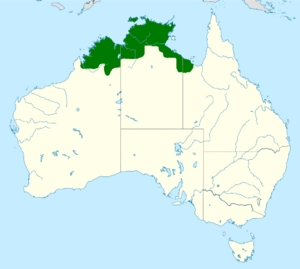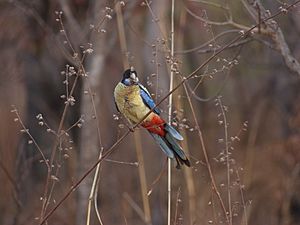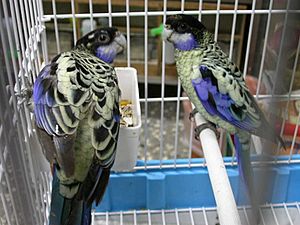Northern rosella facts for kids
Quick facts for kids Northern rosella |
|
|---|---|
 |
|
| Conservation status | |
| Scientific classification | |
| Genus: |
Platycercus
|
| Species: |
venustus
|
 |
|
| Range (in green) in Australia | |
The northern rosella (Platycercus venustus) is a beautiful parrot found in northern Australia. It lives in places like the Gulf of Carpentaria, Arnhem Land, and the Kimberley region. This bird was first described by a scientist named Heinrich Kuhl in 1820. There are two main types, or subspecies, of the northern rosella.
This rosella looks different from other rosellas. It has a dark head and neck, but its cheeks are pale. In the Northern Territory, its cheeks are mostly white. In Western Australia, they are more blue. The northern rosella's back and shoulders are black with thin yellow lines. Its belly and lower back are pale yellow with thin black lines. It has a long blue-green tail and wings that are black and blue-purple. Male and female rosellas look very similar. However, females and younger birds are usually a bit duller in color and might have some red spots.
Northern rosellas live in woodlands and open grassy areas. They mostly eat plants, especially seeds from grasses and eucalyptus trees. They also enjoy flowers, berries, and sometimes even insects. They build their nests in holes inside trees. Even though you don't see them everywhere, the northern rosella is not considered endangered. It is listed as "least concern" by the International Union for Conservation of Nature (IUCN).
Contents
How This Bird Got Its Name
The northern rosella was first named Psittacus venustus by a German scientist, Heinrich Kuhl, in 1820. He based his description on a drawing by Ferdinand Bauer. This drawing came from a bird collected by Robert Brown in 1803. The name venustus comes from a Latin word meaning "charming" or "lovely."
Another scientist, Coenraad Jacob Temminck, later named it Psittacus brownii to honor Robert Brown. In 1827, Nicholas Aylward Vigors moved it to the genus Platycercus. He called it the "most beautiful of the family." But in 1865, John Gould said that the older name, venustus, should be used.
In 1910, Gregory Mathews described a different type, or subspecies, called P. venustus hillii. This type was found in Western Australia. He noticed its cheeks were more blue and less white than the other type. The Victoria River in the Northern Territory is the dividing line between these two subspecies. Scientists have found that hillii also has brighter yellow feathers on its chest and belly. Its beak is also consistently longer and wider. Another subspecies from Melville Island was described in 1912, but scientists now think it's the same as the main type.
The official name for this bird is "northern rosella." In the past, it was also called Brown's rosella or the smutty rosella. "Smutty" came from its dark feathers. Later, this name was changed to "sooty parrot." Local Indigenous people in Arnhem Land have their own names for the bird, like Bulawirdwird and Djaddokorddokord.
The northern rosella is one of six types of rosellas in the Platycercus group. It is closely related to the eastern and pale-headed rosella. Scientists have studied their DNA to understand how these birds are related. One study in 2017 suggested that the eastern rosella was an early relative. This means that different types of rosellas can sometimes breed together.
What Does It Look Like?
The northern rosella is smaller than most other rosella species. An adult bird weighs about 90 to 110 grams (3.2 to 3.9 oz) and is 29 to 32 centimeters (11 to 13 in) long. It has wide wings, with a wingspan of about 44 centimeters (17 in). Its tail is long and has twelve feathers.
Male and female northern rosellas look almost the same. However, some adult females might have slightly duller colors. They might also have a few red feathers on their head and chest.
The adult bird has a black forehead, crown, and upper neck. Its throat is whitish. It has large cheek-patches. In the main subspecies, these patches are mostly white with violet at the bottom. In the hillii subspecies, they are more blue with a narrow white top part. The feathers on its lower neck and shoulders are black with thin yellow edges, which makes them look scalloped. The feathers on its back, rump, and belly are pale yellow with black edges. The feathers under its tail are red with black edges.
The central feathers of its long tail are dark green, turning dark blue at the tips. The other tail feathers are dark blue with pale blue and white tips. The underside of its tail is pale blue with a white tip. When the wings are at rest, they show a wide purplish-blue patch on the shoulder. The beak is off-white with a grey area at the base. Its legs and feet are grey, and its eyes are dark brown. Young birds look like adults but are not as brightly colored. Their black feathers are more grayish, and they are more likely to have scattered red feathers on their head and body.
Where Does It Live?
The northern rosella lives across the northern parts of Australia. In Western Australia, you can find it in the Kimberley region. This includes areas around Derby and the Wunaamin Miliwundi Ranges. Sometimes, they are seen in places like Halls Creek.
In the Northern Territory, they live from the Victoria River north to the Tiwi Islands. They also live across western and northern Arnhem Land, including Milingimbi Island and the Wessel Islands. You can also find them further east, along the western and southern coast of the Gulf of Carpentaria. They go as far south as Borroloola and into western Queensland near the Nicholson River.
The northern rosella prefers open forests and woodlands with lots of grass. These areas often have eucalyptus trees, as well as Melaleuca, Callitris, and Acacia trees. They also live near small creeks, in gorges, and on sandstone cliffs. Sometimes, they are found on forested islands off the coast. You might even spot them in mangroves or parks in suburban Darwin. They usually avoid very dense forests.
How It Behaves
The northern rosella is not a very social bird. You will usually see it alone or in pairs. Sometimes, a few birds might perch together in the same tree. Occasionally, you might see larger groups, usually 6 to 8 birds, but rarely up to 15. This bird is shyer than other rosellas. If something disturbs it, it will quickly fly up into the tops of the trees.
Northern rosellas are quieter and don't make as much noise as other rosellas. Scientists haven't studied their calls very much. When they fly, they make a sharp, short chit-chut chit-chut sound to keep in touch. When they are sitting, they make a three-note whistle that goes up in pitch, or metallic piping sounds. You might hear soft chattering when they are eating. They also chatter sometimes when they are squabbling at the start of the breeding season.
Reproduction and Family Life
Northern rosellas build their nests in holes inside trees, often eucalyptus trees near water. They usually nest during the Southern Hemisphere winter. A female rosella will lay anywhere from two to five white eggs. The eggs are about 26 by 21 millimeters (1 by 0.8 in) in size.
The female bird sits on the eggs by herself for about 19 or 20 days. When the chicks hatch, they are covered in long white fuzz and cannot do much for themselves. They stay in the nest for about seven weeks after hatching. Both parents feed the young birds. After they leave the nest, the young rosellas stay with their parents for a year or more. They often feed together in small family groups.
What's for Dinner?
The northern rosella finds its food on the ground in grassy clearings in woodlands. It also looks for food on roadsides and riverbanks. It also eats in the tops of trees. It mainly eats seeds, especially from eucalyptus trees, wattles, cypress trees, and grasses.
It eats both the seeds and nectar from trees like white gum, Darwin stringybark, and fibrebark. It also eats flowers, such as those from Darwin woollybutt, and various fruits. Sometimes, it also eats insects, both young ones (larvae) and adult insects.
Who Eats the Rosella?
The northern rosella can be eaten by predators like the rufous owl. It can also have tiny parasites, like the bird louse Forficuloecus wilsoni.
Protecting the Rosella
The International Union for Conservation of Nature (IUCN) lists the northern rosella as a "species of least concern." This means it is not currently in danger of disappearing. It has a large area where it lives, and its population seems to be stable. There is no sign that its numbers are dropping a lot.
Even though it's not endangered, the northern rosella is not a very common bird. Things like livestock grazing and frequent fires in grassy woodlands might have a bad effect on the number of northern rosellas. Like most parrots, the northern rosella is protected by an agreement called CITES. This agreement makes it illegal to import, export, or trade wild-caught northern rosellas. This helps protect them from being taken from their natural homes.
Keeping Rosellas
Most northern rosellas kept in captivity in Australia are the main subspecies. However, there are some with blue cheeks that are either the hillii subspecies or a mix. Their beautiful colors make them popular birds to keep. In other parts of the world, northern rosellas kept in captivity have been known to breed during the same months as they do in Australia. Because they breed early in the season, eggs laid in cooler parts of Australia might not hatch well. Some breeders have tried using sprinklers in their bird enclosures to encourage them to breed at different times.
See also
 In Spanish: Rosella del Norte para niños
In Spanish: Rosella del Norte para niños





